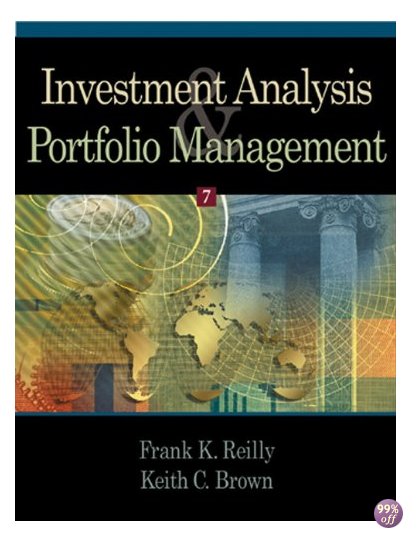Test Bank for Investment Analysis and Portfolio Management 10th Edition by Reilly
$35.00 Original price was: $35.00.$26.50Current price is: $26.50.
Test Bank for Investment Analysis and Portfolio Management 10th Edition by Reilly
This is completed downloadable of Test Bank for Investment Analysis and Portfolio Management 10th Edition by Reilly

Product Details:
- ISBN-10 : 0538482109
- ISBN-13 : 978-0538482103
- Author: Frank K. Reilly (Author), Keith C. Brown (Author)
INVESTMENT ANALYSIS AND PORTFOLIO MANAGEMENT, Tenth Edition, teaches readers how to manage their money to derive the maximum benefit from what they earn. From asset allocation to selecting investments in a global market, this book gives readers a solid foundation in personal finance and presents the same tools used extensively by professionals, organizations, and schools across the country. Filled with real-world illustrations and hands-on applications, this book takes a rigorous, empirical approach to modern topics such as investment instruments, capital markets, behavioral finance, international investing, globalization, the impact of the 2008 financial market crisis, and changes in rating agencies and government agencies such as Fannie Mae and Freddie Mac. Practical and up-to-date, the book is an excellent resource for those with both a theoretical and practical need for investment expertise.
Table of Content:
- Part 1: The Investment Background
- Ch 1: The Investment Setting
- 1.1 What is an Investment?
- 1.2 Measures of Return and Risk
- 1.3 Determinants of Required Rates of Return
- 1.4 Relationship between Risk and Return
- Summary
- Suggested Readings
- Question
- Problems
- Appendix Chapter 1
- Ch 2: The Asset Allocation Decision
- 2.1 Individual Investor Life Cycle
- 2.2 The Portfolio Management Process
- 2.3 The Need for a Policy Statement
- 2.4 Input to the Policy Statement
- 2.5 Constructing the Policy Statement
- 2.6 The Importance of Asset Allocation
- Summary
- Suggested Readings
- Questions
- Problems
- Appendix Chapter 2
- Ch 3: Selecting Investments in a Global Market
- 3.1 The Case for Global Investments
- 3.2 Global Investment Choices
- 3.3 Historical Risk-Returns on Alternative Investments
- Summary
- Suggested Readings
- Questions
- Problems
- Appendix Chapter 3
- Ch 4: Organization and Functioning of Securities Markets
- 4.1 What is a Market?
- 4.2 Primary Capital Markets
- 4.3 Secondary Financial Markets
- 4.4 Classification of U.S. Secondary Equity Markets
- 4.5 Alternative Types of Orders Available
- Summary
- Suggested Readings
- Questions
- Problems
- Ch 5: Security Market Indexes
- 5.1 Uses of Security-Market Indexes
- 5.2 Differentiating Factors in Constructing Market Indexes
- 5.3 Stock-Market Indexes
- 5.4 Bond-Market Indexes
- 5.5 Composite Stock-Bond Indexes
- 5.6 Comparison of Indexes Over Time
- Summary
- Suggested Readings
- Questions
- Appendix Chapter 5
- Part 2: Developments in Investment Theory
- Ch 6: Efficient Capital Markets
- 6.1 Why Should Capital Markets Be Efficient?
- 6.2 Alternative Efficient Market Hypotheses
- 6.3 Tests and Results of Efficient Market Hypotheses
- 6.4 Behavioral Finance
- 6.5 Implications of Efficient Capital Markets
- Summary
- Suggested Readings
- Questions
- Problems
- Ch 7: An Introduction to Portfolio Management
- 7.1 Some Background Assumptions
- 7.2 Markowitz Portfolio Theory
- Summary
- Suggested Readings
- Questions
- Problems
- Appendix Chapter 7
- Ch 8: An Introduction to Asset Pricing Models
- 8.1 Capital Market Theory: An Overview
- 8.2 The Capital Asset Pricing Model
- 8.3 Relaxing the Assumptions
- 8.4 Additional Empirical Tests of the CAPM
- 8.5 The Market Portfolio: Theory versus Practice
- Summary
- Suggested Readings
- Questions
- Problems
- Ch 9: Multifactor Models of Risk and Return
- 9.1 Arbitrage Pricing Theory
- 9.2 Multifactor Models and Risk Estimation
- Summary
- Suggested Readings
- Questions
- Problems
- Part 3: Valuation Principles and Practices
- Ch 10: Analysis of Financial Statements
- 10.1 Major Financial Statements
- 10.2 Analysis of Financial Ratios
- 10.3 Computation of Financial Ratios
- 10.4 Evaluating Internal Liquidity
- 10.5 Evaluating Operating Performance
- 10.6 Risk Analysis
- 10.7 Analysis of Growth Potential
- 10.8 Comparative Analysis of Ratios
- 10.9 Analysis of Non-U.S. Financial Statements
- 10.10 The Quality of Financial Statements
- 10.11 The Value of Financial Statement Analysis
- 10.12 Specific Uses of Financial Ratios
- Summary
- Suggested Readings
- Questions
- Problems
- Ch 11: An Introduction to Security Valuation
- 11.1 An Overview of the Valuation Process
- 11.2 Why a Three-Step Valuation Process?
- 11.3 Theory of Valuation
- 11.4 Valuation of Alternative Investments
- 11.5 Relative Valuation Techniques
- 11.6 Estimating the Inputs: The Required Rate of Return and the Expected Growth Rate of Valuation Va
- Appendix Chapter 11
- Part 4: Analysis and Management of Common Stocks
- Ch 12: Macroanalysis and Microvaluation of the Stock Market
- 12.1 The Components of Market Analysis
- 12.2 Macromarket Analysis
- 12.3 Microvaluation Analysis
- 12.4 Valuation Using the Earnings Multiplier Approach
- 12.5 Estimating Expected Earnings per Share
- 12.6 Estimating the Stock Market Earnings Multiplier
- 12.7 Microvaluation of World Markets
- Summary
- Suggested Readings
- Questions
- Problems
- Ch 13: Industry Analysis
- 13.1 Why Do Industry Analysis?
- 13.2 The Business Cycle and Industry Sectors
- 13.3 Structural Economic Changes and Alternative Industries
- 13.4 Evaluating the Industry Life Cycle
- 13.5 Analysis of Industry Competition
- 13.6 Estimating Industry Rates of Return
- 13.7 Industry Analysis Using the Relative Valuation Approach
- 13.8 Other Relative Valuation Ratios
- 13.9 Global Industry Analysis
- Summary
- Suggested Readings
- Questions
- Problems
- Appendix Chapter 13
- Ch 14: Company Analysis and Stock Valuation
- 14.1 Company Analysis versus Stock Valuation
- 14.2 Economic, Industry, and Structural Links to Company Analysis
- 14.3 Company Analysis
- 14.4 Estimating Intrinsic Value
- 14.5 Estimating Company Earnings per Share
- 14.6 Walgreen Co.’s Competitive Strategies
- 14.7 Estimating Company Earnings Multipliers
- 14.8 Additional Measures of Relative Value
- 14.9 Analysis of Growth Companies
- 14.10 Measures of Value Added
- 14.11 Site Visits and the Art of the Interview
- 14.12 When to Sell
- 14.13 Influences on Analysts
- 14.14 Global Company and Stock Analysis
- Summary
- Suggested Readings
- Questions
- Problems
- Ch 15: Technical Analysis
- Underlying Assumptions of Technical Analysis
- Advantages of Technical Analysis
- Challenges to Technical Analysis
- Technical Trading Rules and Indicators
- Technical Analysis of Foreign Markets
- Technical Analysis of Bond Markets
- Ch 16: Equity Portfolio Management Strategies
- 16.1 Passive versus Active Management
- 16.2 An Overview of Passive Equity Portfolio Management Strategies
- 16.3 An Overview of Active Equity Portfolio Management Strategies
- 16.4 Value versus Growth Investing: A Closer Look
- 16.5 An Overview of Style Analysis
- 16.6 Asset Allocation Strategies
- Summary
- Suggested Readings
- Questions
- Problems
- Part 5: Analysis and Management of Bonds
- Ch 17: Bond Fundamentals
- 17.1 Basic Features of a Bond
- 17.2 The Global Bond Market Structure
- 17.3 Alternative Bond Issues
- 17.4 Obtaining Information on Bond Prices
- Summary
- Suggested Readings
- Questions
- Problems
- Ch 18: The Analysis and Valuation of Bonds
- 18.1 The Fundamentals of Bond Valuation
- 18.2 Computing Bond Yields
- 18.3 Calculating Future Bond Prices
- 18.4 Bond Valuation Using Spot Rates
- 18.5 What Determines Interest Rates?
- 18.6 Calculating Forward Rates from the Spot Rate Curve
- 18.7 Term Structure Theories
- 18.8 What Determines the Price Volatility for Bonds?
- 18.9 Yield Spreads with Embedded Options
- Summary
- Suggested Readings
- Questions
- Problems
- Ch 19: Bond Portfolio Management Strategies
- 19.1 Bond Portfolio Performance, Style, and Strategy
- 19.2 Passive Management Strategies
- 19.3 Active Management Strategies
- 19.4 Core-Plus Management Strategies
- 19.5 Matched-Funding Management Strategies
- 19.6 Contingent and Structured Management Strategies
- Summary
- Suggested Readings
- Questions
- Problems
- Appendix Chapter 19
- Part 6: Derivative Security Analysis
- Ch 20: An Introduction to Derivative Markets and Securities
- 20.1 Overview of Derivative Markets
- 20.2 Investing with Derivative Securities
- 20.3 The Relationship between Forward and Option Contracts
- 20.4 An Introduction to the Use of Derivatives in Portfolio Management
- Summary
- Suggested Readings
- Questions
- Problems
- Ch 21: Forward and Futures Contracts
- 21.1 An Overview of Forward and Futures Trading
- 21.2 Hedging with Forwards and Futures
- 21.3 Forward and Futures Contracts: Basic Valuation Concepts
- 21.4 Financial Forwards and Futures: Applications and Strategies
- Summary
- Suggested Readings
- Questions
- Problems
- Appendix Chapter 21
- Ch 22: Option Contracts
- 22.1 An Overview of Option Markets and Contracts
- 22.2 The Fundamentals of Option Valuation
- 22.3 Option Valuation: Extensions and Advanced Topics
- 22.4 Option Trading Strategies
- Summary
- Suggested Readings
- Questions
- Problems
- Ch 23: Swap Contracts, Convertible Securities, and Other Embedded Derivatives
- 23.1 OTC Interest Rate Agreements
- 23.2 Swap Contracting Extensions
- 23.3 Warrants and Convertible Securities
- 23.4 Other Embedded Derivatives
- 23.5 Valuing Flexibility: An Introduction to Real Options
- Summary
- Suggested Readings
- Questions
- Problems
- Part 7: Specification and Evaluation of Asset Management
- Ch 24: Professional Money Management, Alternative Management, Alternative
- 24.1 The Asset Management Industry: Structure and Evolution
- 24.2 Private Management and Advisory Firms
- 24.3 Organization and Management of Investment Companies
- 24.4 Investing in Alternative Asset Classes
- 24.5 Ethics and Regulation in the Professional Asset Management Industry
- 24.6 What Do You Want from a Professional Asset Manager?
- Summary
- Suggested Readings
- Questions
- Problems
- Ch 25: Evaluation of Portfolio Performance
- 25.1 What is Required of a Portfolio Manager?
- 25.2 Early Performance Measurement Techniques
- 25.3 Composite Portfolio Performance Measures
- 25.4 Application of Portfolio Performance Measures
- 25.5 Portfolio Performance Evaluation: Some Extensions
- 25.6 Factors That Affect Use of Performance Measures
- 25.7 Evaluation of Bond Portfolio Performance
- 25.8 Reporting Investment Performance
- Summary
- Suggested Readings
- Questions
- Problems
- Appendix A: How to Become a CFA Charterholder
- Appendix B: Code of Ethics and Standards of Professional Conduct
- Appendix C: Interest Tables
- Appendix D: Standard Normal Probabilities
- Comprehensive References List
- Glossary
- Index
People Also Search:
investment analysis and portfolio management 10th edition by reilly
investment analysis and portfolio management 10th edition by reilly download scribd
investment analysis and portfolio management 10th edition by reilly test bank download pdf
Related products
Test Bank
Test Bank for Essentials of Business Law and the Legal Environment, 11th Edition: Richard A. Mann











